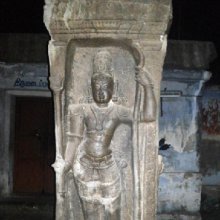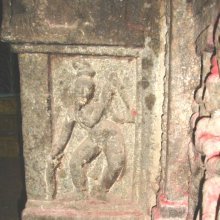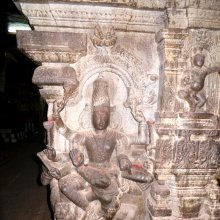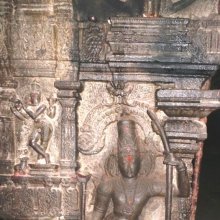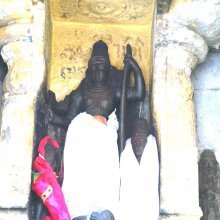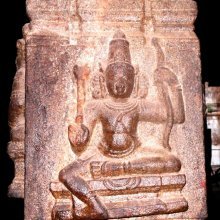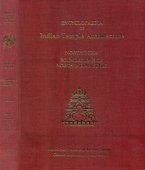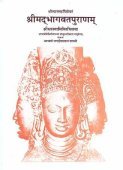Bana, Bāṇa: 47 definitions
Introduction:
Bana means something in Buddhism, Pali, Hinduism, Sanskrit, Jainism, Prakrit, the history of ancient India, Marathi, Hindi, biology. If you want to know the exact meaning, history, etymology or English translation of this term then check out the descriptions on this page. Add your comment or reference to a book if you want to contribute to this summary article.
Alternative spellings of this word include Baan.
Images (photo gallery)
(+6 more images available)
In Hinduism
Natyashastra (theatrics and dramaturgy)
Source: archive.org: The mirror of gesture (abhinaya-darpana)One of the additional Single Hands (hasta):—Bāṇa (arrow): the three fingers joined just touch the thumb, and the little finger is extended. Usage: the number six, Nāla-nṛtya.

Natyashastra (नाट्यशास्त्र, nāṭyaśāstra) refers to both the ancient Indian tradition (shastra) of performing arts, (natya—theatrics, drama, dance, music), as well as the name of a Sanskrit work dealing with these subjects. It also teaches the rules for composing Dramatic plays (nataka), construction and performance of Theater, and Poetic works (kavya).
Shaktism (Shakta philosophy)
Source: Wisdom Library: Śrīmad Devī BhāgavatamBāṇa (बाण):—One of the persons joining Śiva during the preparations of the war between Śankhacūḍa and the Devas, according to the Devī-bhāgavata-purāṇa (9.20.22-53). All persons attending were remained seated on beautiful aerial cars, built of jewels and gems. The war was initiated by Puṣpadanta (messenger of Śiva) who was ordered to restore the rights of the Devas. .
Source: Google Books: Manthanabhairavatantram1) Bāṇa (बाण) refers to the “(five) arrows” of God Kāmarūpa, according to the Ṣaṭsāhasrasaṃhitā, an expansion of the Kubjikāmatatantra: the earliest popular and most authoritative Tantra of the Kubjikā cult.—Accordingly, “[...] O goddess, I will (now) tell you about the god of Kāmarūpa. (His) city is fashioned all around with pillars of sapphire. It has palaces, mansions, arches, banners, goads, and bows. The god holds five arrows [i.e., pañca-bāṇa-dhara] and is accompanied by Kāmeśvarī. Without a body and in the form of light, he melts away the entire universe. He is the lord of the fourteen worlds and holds the staff (of authority). Everything, including passion and the rest, takes place impelled by his will. Thus, it is located in the foremost portion, above Mind Beyond Mind. O Pārvatī, one should meditate on it above the Cavity of Brahmā within the End of the Twelve”.
2) Baṇā (बणा) refers to one of the thirty-two Bhairavīs (also Dūtis) embodying the syllables of the goddess’s Vidyā, according to the Manthānabhairavatantra, a vast sprawling work that belongs to a corpus of Tantric texts concerned with the worship of the goddess Kubjikā.—The thirty-two Bhairavīs [i.e., Baṇā] are the consorts of the Bhairavas presiding over the sonic energies of the thirty-two syllables of her Vidyā.
Source: Brill: Śaivism and the Tantric Traditions (shaktism)Bāṇa (बाण) refers to the “arrows (of Kāma)”, according to Sāhib Kaul’s Śārikāstrotra.—Accordingly, “[...] He who remembers your next syllable, which is īśa with abja, vahni, and padma, is remembered by goddesses in heaven, Nāga maidens in the netherworld, and women on earth confused by the arrows of Kāma (māra-bāṇa). One of pure mind who recites with complete devotion the lakṣmī-syllable, which is difficult for bad people to obtain, him the goddess of good fortune will always be eager to see, and although unsteady (by nature) she will remain at his doorstep out of devotion. [...]”.

Shakta (शाक्त, śākta) or Shaktism (śāktism) represents a tradition of Hinduism where the Goddess (Devi) is revered and worshipped. Shakta literature includes a range of scriptures, including various Agamas and Tantras, although its roots may be traced back to the Vedas.
Pancaratra (worship of Nārāyaṇa)
Source: Wisdom Library: PāñcarātraBāṇa (बाण, “arrows”):—One of the nine symbols representing the cosmic principles of the universe, according to the Pāñcarātra literature. These nine weapons and ornaments symbolize the principles which they represent as the presiding deity. The Arrows (bāṇa) represent the five senses.

Pancaratra (पाञ्चरात्र, pāñcarātra) represents a tradition of Hinduism where Narayana is revered and worshipped. Closeley related to Vaishnavism, the Pancaratra literature includes various Agamas and tantras incorporating many Vaishnava philosophies.
Shilpashastra (iconography)
Source: Google Books: Elements of Hindu iconographyBāṇa or the arrow is so represented as to appear to be made of wood, and is tipped with a metallic point, its tail-end having a few feathers stuck in it. The arrows are put into a quiver slung on the back. An arrow is extracted from it for use with the aid of the fore-finger and the middle-finger.
Source: Shodhganga: The significance of the mūla-beras (śilpa)Bāṇa (बाण, “arrow”) refers to one of the several “attributes” (āyudha) or “accessories” of a detiy commonly seen depicted in Hindu iconography, defined according to texts dealing with śilpa (arts and crafs), known as śilpaśāstras.—Bāṇa or the arrow is so represented as to appear to be made of wood, and is tipped with a metallic point, its tail end having a few feathers stuck in it. The arrows are put into a quiver slung on the back. An arrow is extracted from it for use with the aid of the forefinger and the middle finger.

Shilpashastra (शिल्पशास्त्र, śilpaśāstra) represents the ancient Indian science (shastra) of creative arts (shilpa) such as sculpture, iconography and painting. Closely related to Vastushastra (architecture), they often share the same literature.
Purana and Itihasa (epic history)
Source: Wisdom Library: Skanda-puranaBāṇa (बाण) is the name of a gaṇa (attendant of Śiva), mentioned in the Skandapurāṇa 4.2.53. In this chapter, Śiva (Giriśa) summons his attendants (gaṇas) and ask them to venture towards the city Vārāṇasī (Kāśī) in order to find out what the yoginīs, the sun-god, Vidhi (Brahmā) were doing there.
While the gaṇas such as Bāṇa were staying at Kāśī, they were desirous but unable of finding a weakness in king Divodaśa who was ruling there. Kāśī is described as a fascinating place beyond the range of Giriśa’s vision, and as a place where yoginīs become ayoginīs, after having come in contact with it. Kāśī is described as having both the power to destroy great delusion, as well as creating it.
The Skandapurāṇa narrates the details and legends surrounding numerous holy pilgrimages (tīrtha-māhātmya) throughout India. It is the largest Mahāpurāṇa composed of over 81,000 metrical verses, with the core text dating from the before the 4th-century CE.
Source: archive.org: Puranic Encyclopedia1) Bāṇa (बाण).—(BĀṆABHAṬṬA) I. A Sanskrit poet who lived in the 7th century A.D. He was a member of the assembly of emperor Harṣavardhana. 'Harṣacarita' (prose) is the most important work of Bāṇa. Though many of the descriptions in this book contain exaggerations it affords plenty of scope for investigation into the features of ancient Sanskrit literature. He has mentioned about Vyāsa, Bhaṭṭāra-hariścandra, Sātavāhana, Pravarasena, Bhāsa, Kālidāsa and such others.
Harṣacarita, in a sense, is a Romance. It is divided into eight Ucchvāsas. From the first two or three chapters informations could be had of Bāṇabhaṭṭa. His mother Rājyadevī died when he was a little boy. At the age of fourteen his father also died. After that he arrived at the palace of Harṣa. The story of Harṣacarita begins with the death of Prabhākara-Vardhana, father of Harṣa. The Book ends with the story incomplete. Harṣacarita is the only historic prose work available in Sanskrit. (See full article at Story of Bāṇa from the Puranic encyclopaedia by Vettam Mani)
2) Bāṇa (बाण).—A mighty and powerful Asura. Genealogy and birth. Descended from Mahāviṣṇu in the following order: Brahmā-Marīci-Kaśyapa-Hiraṇyakaśipu-Pṛahlāda-Virocana-Mahābali-Bāṇa. Getting a boon. Bāṇa began his reign with the city of Śoṇitapura as his capital. Then he went to the vicinity of the Himālayas and began to do penance thinking of Śiva. Śiva made his appearance and asked him what he wanted. He requested that he should be considered as the son of Pārvatī and that he should be given thousand hands so as to destroy all his enemies. Śiva granted him the boon. From that day onwards Pārvatī considered him as the younger brother of Subrahmaṇya. He returned to his Kingdom and began to reign. Battle with Śrī Kṛṣṇa and his fall. (See the word Aniruddha). Other information. (1) In the Purāṇas Bāṇāsura is often called by the name Mahākāla, which is the name of an attendant of Śiva. (Mahābhārata, Ādi Parva, Chapter 65, Stanza 20).
2) Śukrācārya (the teacher of the Asuras) always worked for the uplift of Bāṇa. (Mahābhārata, Sabhā Parva, Chapter 38, Stanza 29).
2) In the Battle with Śrī Kṛṣṇa, Bāṇa was helped by Śiva, Subrahmaṇya, and the Gods like Agni (fire) and others. (Mahābhārata, Sabhā Parva, Chapter 38).
2) Śrī Kṛṣṇa cut down the thousand hands of Bāṇa with his Cakrāyudha (the wheel weapon). (Mahābhārata, Sabhā Parva, Chapter 38).
2) Bāṇa often stood under the cover of the mountain of Krauñca and attacked the devas (gods). So once Subrahmaṇya had to cut the mountain Krauñca with his arrows. (Mahābhārata, Śalya Parva, Chapter 46, Stanza 82).
3) Bāṇa (बाण).—A warrior of Subrahmaṇya. Mention is made about this Bāṇa in Mahābhārata, Śalya Parva, Chapter 45, Stanza 67.
4) Bāṇa (बाण).—An asura. During the regime of Śrī Rāma this Asura fought against the King and his brothers. A Śivaliṅga had been consecrated in the throat of this asura. So it was not possible for Lakṣmaṇa to defeat him though he had fought with him for so many days. Lakṣmaṇa heard an etherial voice saying, "Unless and until the image of Śivaliṅga is removed from his throat Bāṇa could not be killed." By the operation of arrows Lakṣmaṇa smashed the image of Śivaliṅga in his throat. With the same arrow he cut the throat of the asura also and thus Bāṇa was killed. (Kampa Rāmāyaṇa, Uttara Kāṇḍa).
Source: archive.org: Shiva Purana - English TranslationBāṇa (बाण) (Cf. Bāṇaka) refers to “arrows”, according to the Śivapurāṇa 2.3.17 (“The dialogue between Indra and Kāmadeva”).—Accordingly, as Kāma said to Brahmā: “[...] O dear friend, I shall cause the downfall of that enemy of yours who is performing a severe penance to usurp your position. [...] I can undoubtedly make Brahmā and Viṣṇu go astray. Others are of no consideration. I shall make even Śiva fall. I have only five arrows that are soft [i.e., pañca-bāṇa—paṃcaiva mṛdavo bāṇāste] and flowery. My bow is of three types. That too is flowery. The bowstring consists of bees. My support and strength is my beloved wife Ratī. Spring is my minister. O god, I am having five forces. The moon, the storehouse of nectar, is my friend. [...]”.
Source: Cologne Digital Sanskrit Dictionaries: The Purana Index1a) Bāṇa (बाण).—The eldest of the one hundred sons of Bali; wife Lohinī and son Indradhanvan; had one thousand arms and was ruling from his capital Śoṇitapura; pleased Śiva by praise; was a devotee of Śiva; and became the head of the gaṇas; in return for his services, the Lord Śiva guarded his city;1 took part in the Devāsura war between Bali and Indra; fought with Sūrya and was helped by his 99 brothers; a friend of Kaṃsa and Jarāsandha; he welcomed Jarāsandha, and offered to help him and sent his two ministers and a vast army with Jarāsandha.2 Once addressed Śiva that he found no use for his thousand arms for there was none to fight him, and even the elephants at the quarters ran away in fear of him; Śiva replied that soon there would be somebody equal to him who would put down his pride of power.3 The marriage of his daughter Uṣā was the cause of a battle between Śiva and Kṛṣṇa; the guards of the harem once reported to Bāṇa that they suspected the presence of some male in Uṣā's palace; soon he found Aniruddha there and imprisoned him to the distress of his daughter; was attacked by Satyakī when Śoṇitapura was besieged by the Vṛṣṇis; found his army scattered and rushed towards Kṛṣṇa leaving Satyakī, when his charioteer and horses were killed; Koṭarā his mother appeared before Kṛṣṇa naked and with dishevelled hair, while Bāṇa entered his city; once again attacked Kṛṣṇa who chopped off his arms when Śiva praised Kṛṣṇa as Brāhmaṇa and pleaded for his devotee, Bāṇa, being left with his four arms remaining; deprived of all except two on account of Aniruddha; release of Aniruddha.4 Capital Tripura. The gods appealed to Rudra and in the meantime Nārada made Bāṇa's wives leave the path of strict chastity and prepared the way for the Asuras' ruin. Rudra put the city to flames; appealing with a liṅga on his head, he was blessed. Attained mokṣa by satsaṅga;5 killed by Kṛṣṇa.6
- 1) Bhāgavata-purāṇa VI. 18. 17-18; X. 62. 2; 88. 16; Brahmāṇḍa-purāṇa III. 5. 42-4; 73. 101; IV, 29. 123; Matsya-purāṇa 6. 10, 13; Vāyu-purāṇa 67. 83; Viṣṇu-purāṇa I. 21. 2; V. 1. 24.
- 2) Bhāgavata-purāṇa VIII. 10. 19, 30; X. 2. 2; 36. 36; [51 (v) 1-18].
- 3) Ib. X. 62. 2-11.
- 4) Ib. X. 62. 1 28-35; 63. 8, 17-21 30-49; 61. 23 (9); III. 3. 11; XI. 12. 5. Viṣṇu-purāṇa V. 32. 7-8; 33. 1-50.
- 5) Matsya-purāṇa Chh. 187-188.
- 6) Vāyu-purāṇa 98. 102.
1b) A son of Danu and Mahāsena.*
- * Matsya-purāṇa 6. 20; 245. 12.
1c) Śiva gaṇas.*
- * Brahmāṇḍa-purāṇa III. 41. 27.
Bāṇa (बाण) is a name mentioned in the Mahābhārata (cf. I.59.19, I.65, IX.44.62) and represents one of the many proper names used for people and places. Note: The Mahābhārata (mentioning Bāṇa) is a Sanskrit epic poem consisting of 100,000 ślokas (metrical verses) and is over 2000 years old.
Source: Shodhganga: The saurapurana - a critical studyBāṇa (बाण) or Bāṇāsura refers to the son of Bali and grandson of Virocana, according to one account of Vaṃśa (‘genealogical description’) of the 10th century Saurapurāṇa: one of the various Upapurāṇas depicting Śaivism.—Accordingly, Prahlāda ascended the throne [after Hiraṇyakaśipu]. His son was Virocana who was killed by Viṣṇu and his son Bali became the king. He was pious and virtuous and was bound to Pātalā by Viṣṇu. Bāṇāsura was the son of Bali, who was a devotee of Śiva. The Lord gave Bāṇāsura the status of the leader of a Gaṇa. The son’s of Bāṇa were Tāra, Śambara, Kapila, Śaṃkara, Svarbhānu and Vṛṣaparvan.

The Purana (पुराण, purāṇas) refers to Sanskrit literature preserving ancient India’s vast cultural history, including historical legends, religious ceremonies, various arts and sciences. The eighteen mahapuranas total over 400,000 shlokas (metrical couplets) and date to at least several centuries BCE.
Dhanurveda (science of warfare)
Source: Wisdom Library: DhanurvedaBāṇa (बाण) refers to a weapon (an arrow, a shaft made of reed). It is a Sanskrit word defined in the Dhanurveda-saṃhitā, which contains a list of no less than 117 weapons. The Dhanurveda-saṃhitā is said to have been composed by the sage Vasiṣṭha, who in turn transmitted it trough a tradition of sages, which can eventually be traced to Śiva and Brahmā.
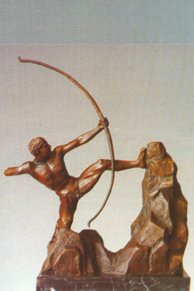
Dhanurveda (धनुर्वेद) refers to the “knowledge of warfare” and, as an upaveda, is associated with the Ṛgveda. It contains instructions on warfare, archery and ancient Indian martial arts, dating back to the 2nd-3rd millennium BCE.
Kavya (poetry)
Source: Wisdom Library: KathāsaritsāgaraBāṇa (बाण) is the name of an Asura who lost his daughter Uṣā to Aniruddha, according to the Kathāsaritsāgara, chapter 31. The story of Bāṇa and Uṣā was narrated by Kaliṅgasenā to Somaprabhā in order to demonstrate the similarity between the story and her situation involving the Udayana (king of Vatsa).
The Kathāsaritsāgara (‘ocean of streams of story’), mentioning Bāṇa, is a famous Sanskrit epic story revolving around prince Naravāhanadatta and his quest to become the emperor of the vidyādharas (celestial beings). The work is said to have been an adaptation of Guṇāḍhya’s Bṛhatkathā consisting of 100,000 verses, which in turn is part of a larger work containing 700,000 verses.
Source: Shodhganga: A critical appreciation of soddhalas udayasundarikathaBāṇa (बाण).—In the Harṣacarita Bāṇa devotes the first two Ucchvāsas and even a portion of the third to biographical matter. Bāṇa gives us a legendary account of the birth of Sārasvata, one of the remote, though not direct ancestors, who was the son of the Goddess Sarasvatī and the sage Dadhīca and the cousin of Vatsa, the progenitor of the mighty race in which Bāṇa was born.
Bāṇa’s father was Citrabhānu who was the son of Arthapati. His great-grand-father was Pāśupata who was the son of Kubera, a descendant of Vatsa. Bāṇa’s mother was Rājadevī who died while the poet was yet a child. He was all the more dear to his father, who was like a mother to him.
His two works, Harṣacarita and Kādambari stand at the head of the two classes of prose i.e. Akhyāhikā and Kathā. Ancient Sanskrit writers have appreciated his worth and bestowed on him due praise.
Soḍḍhala refers to him frequently in his work. He has been made a character of the story in the name of Tilaka, who listened to his Udayasundarīkathā and became free from the curse.

Kavya (काव्य, kavya) refers to Sanskrit poetry, a popular ancient Indian tradition of literature. There have been many Sanskrit poets over the ages, hailing from ancient India and beyond. This topic includes mahakavya, or ‘epic poetry’ and natya, or ‘dramatic poetry’.
Jyotisha (astronomy and astrology)
Source: Wisdom Library: Brihat Samhita by VarahamihiraBāṇa (बाण) refers to a kind of black flower, according to the Bṛhatsaṃhitā (chapter 10), an encyclopedic Sanskrit work written by Varāhamihira mainly focusing on the science of ancient Indian astronomy astronomy (Jyotiṣa).—Accordingly, “If, while Saturn is in Kṛttikā, Jupiter should be in the constellation of Viśākhā, mankind will then become very wicked. If both the planets should be in one and the same constellation, the chief towns will suffer. If Saturn should appear variegated in colour, birds will perish; if yellow, there will be fear from hunger; if of blood colour, there will be wars in the land and if of ashy colour, mankind will be very much at strife. If Saturn should appear as bright as the Vaidūrya gem or pure or of the colour of the Bāṇa (a black flower) or Atasī flower, mankind will be happy. Whatever may be the colour of Saturn, the persons who or objects which correspond to the particular colour will suffer”.
Source: Wikibooks (hi): Sanskrit Technical TermsBāṇa (बाण).—1. Arrow. 2. Height of an arc or segment of a circle. Note: Bāṇa is a Sanskrit technical term used in ancient Indian sciences such as Astronomy, Mathematics and Geometry.

Jyotisha (ज्योतिष, jyotiṣa or jyotish) refers to ‘astronomy’ or “Vedic astrology” and represents the fifth of the six Vedangas (additional sciences to be studied along with the Vedas). Jyotisha concerns itself with the study and prediction of the movements of celestial bodies, in order to calculate the auspicious time for rituals and ceremonies.
Ganitashastra (Mathematics and Algebra)
Source: archive.org: Hindu MathematicsBāṇa (बाण) represents the number 5 (five) in the “word-numeral system” (bhūtasaṃkhyā), which was used in Sanskrit texts dealing with astronomy, mathematics, metrics, as well as in the dates of inscriptions and manuscripts in ancient Indian literature.—A system of expressing numbers by means of words arranged as in the place-value notation was developed and perfected in India in the early centuries of the Christian era. In this system the numerals [e.g., 5—bāṇa] are expressed by names of things, beings or concepts, which, naturally or in accordance with the teaching of the Śāstras, connote numbers.
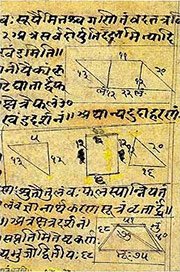
Ganitashastra (शिल्पशास्त्र, gaṇitaśāstra) refers to the ancient Indian science of mathematics, algebra, number theory, arithmetic, etc. Closely allied with astronomy, both were commonly taught and studied in universities, even since the 1st millennium BCE. Ganita-shastra also includes ritualistic math-books such as the Shulba-sutras.
Shaivism (Shaiva philosophy)
Source: SOAS University of London: Protective Rites in the Netra TantraBāṇa (बाण) refers to an “arrow”, according to the Netratantra of Kṣemarāja: a Śaiva text from the 9th century in which Śiva (Bhairava) teaches Pārvatī topics such as metaphysics, cosmology, and soteriology.—Accordingly, [verse 9.19cd-26, while instructing to visualize Sadāśiva in order to worship the formless Amṛteśa]—“[He] resembles the swelling moon, a heap of mountain snow. Five-faced, large-eyed, ten-armed, [and] three-armed, [he] has a serpent as a sacred thread. He is covered in a garment made of tiger skin. [He] sits in the bound lotus pose atop a white lotus, [holding] a trident, blue lotus, arrow (bāṇa), rudrākṣa, [and] a mallet. [...]”.

Shaiva (शैव, śaiva) or Shaivism (śaivism) represents a tradition of Hinduism worshiping Shiva as the supreme being. Closely related to Shaktism, Shaiva literature includes a range of scriptures, including Tantras, while the root of this tradition may be traced back to the ancient Vedas.
Kama-shastra (the science of Love-making)
Source: Shodhganga: Elements of Art and Architecture in the Trtiyakhanda of the Visnudharmottarapurana (kama)Bāṇa (बाण) refers to “frames”.—Cf. Paṭṭikāvetrabāṇavikalpa which refers to “caning of wood frames of coats, chairs etc.”, representing one of the “sixty four kinds of Art”, according to the Kāmasūtra of Vātsyāyaṇa.—Indian tradition, basically includes sixty four Art forms are acknowledged. The references of sixty four kinds of kalā are found in the Bhāgavatapurāṇa, Śaiva-Tantras, Kāmasūtra of Vātsyāyaṇa etc.
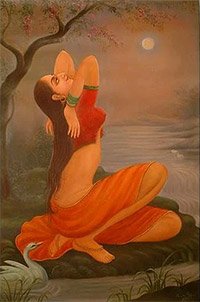
Kamashastra (कामशास्त्र, kāmaśāstra) deals with ancient Indian science of love-making, passion, emotions and other related topics dealing with the pleasures of the senses.
General definition (in Hinduism)
Source: Wisdom Library: HinduismBāṇa (बाण) is a Sanskrit word translating to “Arrow”.
Source: archive.org: Vedic index of Names and SubjectsBāṇa (बाण) denotes “arrow” in the Ṛgveda (vi. 75, 17) and later (Av. iii. 23, 2; vi. 105, 2, etc.).
Source: Apam Napat: Indian MythologyBana is a King of the solar dynasty and an ancestor of Rama. He is the son of Vikukshi and the father of Anaranya.In Buddhism
Tibetan Buddhism (Vajrayana or tantric Buddhism)
Source: academia.edu: The Structure and Meanings of the Heruka MaṇḍalaBāṇa (बाण) refers to an “arrow” and represents one of the items held in the right hand of Heruka: one of the main deities of the Herukamaṇḍala described in the 10th century Ḍākārṇava chapter 15. Heruka is positioned in the Lotus (padma) at the center; He is the origin of all heroes; He has 17 faces (with three eyes on each) and 76 arms [holding, for example, bāṇa]; He is half black and half green in color; He is dancing on a flaming sun placed on Bhairava and Kālarātrī.
Source: OSU Press: Cakrasamvara SamadhiBāṇa (बाण) [=vāṇa?] refers to an “arrow”, according to the Cakrasaṃvara Samādhi [i.e., Cakrasamvara Meditation] ritual often performed in combination with the Cakrasaṃvara Samādhi, which refers to the primary pūjā and sādhanā practice of Newah Mahāyāna-Vajrayāna Buddhists in Nepal.—Accordingly, “By the form of a skull cup, and by the letter Māṃ, Vāruṇī, Eighteen arms, one face, red color, and three eyes, A sword, arrow (vāṇa) and hook, on the right, a skull cup, ax and banner, Thus a mace, thus a bell, and in the ninth, granting wishes, A two-headed drum, a bow and noose, a staff and a water pot, A trident, hammer and lute, and thus a number, in the upper hand, A young adolescent beauty, a great beauty, a beautiful goddess”.

Tibetan Buddhism includes schools such as Nyingma, Kadampa, Kagyu and Gelug. Their primary canon of literature is divided in two broad categories: The Kangyur, which consists of Buddha’s words, and the Tengyur, which includes commentaries from various sources. Esotericism and tantra techniques (vajrayāna) are collected indepently.
In Jainism
General definition (in Jainism)
Source: The University of Sydney: A study of the Twelve ReflectionsBāṇa (बाण) refers to “arrows”, according to the 11th century Jñānārṇava, a treatise on Jain Yoga in roughly 2200 Sanskrit verses composed by Śubhacandra.—Accordingly, “That which is evidently cessation of action causing the cycle of rebirth is to be considered as the mental stopping of the influx of karma by those who know about that from the most excellent scripture. Like the hero who is well-clad in armour is not pierced by arrows (bāṇa) in the difficulty of battle, the one who has subdued his senses, whose self is restrained, is not pierced by arrows which are made of non-restraint”.

Jainism is an Indian religion of Dharma whose doctrine revolves around harmlessness (ahimsa) towards every living being. The two major branches (Digambara and Svetambara) of Jainism stimulate self-control (or, shramana, ‘self-reliance’) and spiritual development through a path of peace for the soul to progess to the ultimate goal.
India history and geography
Source: Cologne Digital Sanskrit Dictionaries: Indian Epigraphical GlossaryBāṇa.—(IE 7-1-2; EI 25), ‘five’. Note: bāṇa is defined in the “Indian epigraphical glossary” as it can be found on ancient inscriptions commonly written in Sanskrit, Prakrit or Dravidian languages.

The history of India traces the identification of countries, villages, towns and other regions of India, as well as mythology, zoology, royal dynasties, rulers, tribes, local festivities and traditions and regional languages. Ancient India enjoyed religious freedom and encourages the path of Dharma, a concept common to Buddhism, Hinduism, and Jainism.
Biology (plants and animals)
Source: Wisdom Library: Local Names of Plants and DrugsBana in the Malayalam language is the name of a plant identified with Barleria montana Nees from the Acanthaceae (Acanthus) family having the following synonyms: Barleria morrisiana, Barleria purpurea. For the possible medicinal usage of bana, you can check this page for potential sources and references, although be aware that any some or none of the side-effects may not be mentioned here, wether they be harmful or beneficial to health.
Bana [बाण] in the Sanskrit language is the name of a plant identified with Barleria cristata L. from the Acanthaceae (Acanthus) family having the following synonyms: Barleria alba, Barleria indica, Barleria napalensis.
Bana [बाण] in the Sanskrit language is the name of a plant identified with Barleria prionitis L. from the Acanthaceae (Acanthus) family having the following synonyms: Barleria appressa, Barleria coriacea, Barleria spicata.
Bana [बाण] in the Sanskrit language is the name of a plant identified with Barleria cristata var. albida Haines from the Acanthaceae (Acanthus) family.
Source: Google Books: CRC World Dictionary (Regional names)1) Bana in Burkina Faso is the name of a plant defined with Ceiba pentandra in various botanical sources. This page contains potential references in Ayurveda, modern medicine, and other folk traditions or local practices It has the synonym Bombax occidentale Spreng. (among others).
2) Bana in India is also identified with Saccharum bengalense It has the synonym Erianthus ciliaris (Andersson) Jeswiet (etc.).
3) Bana is also identified with Vitex negundo It has the synonym Vitex paniculata Lam. (etc.).
4) Bana in Senegal is also identified with Boscia senegalensis It has the synonym Boscia octandra Fenzl ex Radlk. (etc.).
Example references for further research on medicinal uses or toxicity (see latin names for full list):
· Taxon (1979)
· De Fructibus et Seminibus Plantarum (1791)
· Journal of the Arnold Arboretum (1947)
· A General History of the Dichlamydeous Plants (1831)
· Agra University Journal of Research (Science) (1957)
· Revisio Generum Plantarum (1891)
If you are looking for specific details regarding Bana, for example health benefits, extract dosage, side effects, chemical composition, diet and recipes, pregnancy safety, have a look at these references.

This sections includes definitions from the five kingdoms of living things: Animals, Plants, Fungi, Protists and Monera. It will include both the official binomial nomenclature (scientific names usually in Latin) as well as regional spellings and variants.
Languages of India and abroad
Pali-English dictionary
Source: BuddhaSasana: Concise Pali-English Dictionarybāṇa : (m.) an arrow.
Source: Sutta: The Pali Text Society's Pali-English DictionaryBāṇa, (cp. Vedic bāṇa) an arrow Mbhv 19. (Page 485)

Pali is the language of the Tipiṭaka, which is the sacred canon of Theravāda Buddhism and contains much of the Buddha’s speech. Closeley related to Sanskrit, both languages are used interchangeably between religions.
Marathi-English dictionary
Source: DDSA: The Molesworth Marathi and English Dictionarybana (बन).—n (Poetry. vana S) A wood, a grove, a plantation. 2 m An order, or an individual of it, of the gōsāvī.
--- OR ---
bāṇa (बाण).—m (S) An arrow. 2 A rocket, whether the missile weapon or a sky-rocket. 3 A stone found in the Narmada river, worshiped as an emblem of Shiva. 4 fig. (Compared from his bareness to the bāṇa or lingam.) A term for a man without wife, or family, or home, or friends, or money. 5 Gunwale of a boat. 6 As intended in the following ex. asō bāṇasaṅkhyā divasānta || suvēlē paryanta jāhālā sata ||. An arrow of kāmadēva the god of love. His quiver is charged with five, viz. aravinda, aśōka, cyūta, nava- mallikā or mōgarā, nīlōtpala. 7 Distance from the ecliptic or celestial latitude.
--- OR ---
bāṇa (बाण).—a (Or nirbāṇa) That has quitted or is without house, family, and worldly concerns. Compare Sig. IV. of bāṇa the noun.
--- OR ---
bāṇā (बाणा).—m ( H) Profession, pretension, priding or pluming one's self (of or upon any particular accomplishment or virtue): also any department, province, field, sphere, peculiar unto; the forte or element of. v bāḷaga. For exemplifications of this latter division of the sense See śāstrībāṇā. 2 A manner or fashion of dress, a costume. 3 A kind of rocket. 4 The woof or weft. 5 A weapon,--a sort of paṭṭā with a thick-edged blade and a wooden hilt.
--- OR ---
bānā (बाना).—m (Better bāṇā) The woof.
Source: DDSA: The Aryabhusan school dictionary, Marathi-Englishbana (बन).—n A wood, a grove.
--- OR ---
bāṇa (बाण).—m An arrow; a rocket.
--- OR ---
bāṇā (बाणा).—m Profession, pretension. Priding or pleasing oneself. A costume.
Marathi is an Indo-European language having over 70 million native speakers people in (predominantly) Maharashtra India. Marathi, like many other Indo-Aryan languages, evolved from early forms of Prakrit, which itself is a subset of Sanskrit, one of the most ancient languages of the world.
Sanskrit dictionary
Source: DDSA: The practical Sanskrit-English dictionaryBāṇa (बाण).—1 An arrow, shaft, reed; Bṛ. Up.3.8.2; धनुष्यमोघं समधत्त बाणम् (dhanuṣyamoghaṃ samadhatta bāṇam) Kumārasambhava 3.66.
2) An aim or mark for arrows.
3) The feathered end of an arrow.
4) The udder of a cow.
5) The body (śarīra); ते प्रकाश्श्याभिवदन्ति वयमेतद्बाणमवष्टभ्य विधारयामः (te prakāśśyābhivadanti vayametadbāṇamavaṣṭabhya vidhārayāmaḥ) Praśna Up.2.2.
6) Name of a demon, son of Bali; cf. उषा (uṣā).
7) Name of a celebrated poet who lived at the court of king Harṣavardhana and flourished in the first half of the seventh century; see App. II). He is the author of कादम्बरी, हर्षचरित (kādambarī, harṣacarita) and of some other works; (Govardhana in his Āryāsaptaśatī 37 speaks in these terms of Bāṇa :-jātā śikhaṇḍinī prāg yathā śikhaṇḍī tathāvagacchāmi | prāgalbhyadhikamāptuṃ vāṇī bāṇo babhūveti ||; so hṛdayavasatiḥ pañcabāṇastu bāṇaḥ P. R.1.22).
8) A symbolical expression for the number 'five'.
9) A sound voice.
1) Fire.
11) Lightning.
12) A form of Śiva.
13) The versed sine of an arc.
-ṇaḥ, -ṇā The hinder part or feathered end of an arrow.
-ṇaḥ, -ṇā, -ṇam a blue flowering Barleria -नीलझिण्टी (nīlajhiṇṭī) (Mar. korhāṃṭī); अनाविलोन्मीलितबाणचक्षुषः (anāvilonmīlitabāṇacakṣuṣaḥ) Kirātārjunīya 4. 28. Śiśupālavadha 6.46.
Derivable forms: bāṇaḥ (बाणः).
Source: Cologne Digital Sanskrit Dictionaries: Shabda-Sagara Sanskrit-English DictionaryBaṇa (बण).—m.
(-ṇaḥ) Sound, noise. E. baṇ to sound, aff. ac .
--- OR ---
Bāṇa (बाण).—m.
(-ṇaḥ) 1. An arrow, a shaft. 2. An aim. 3. The udder of a cow. 4. The feathered end of an arrow. 5. A kind of creeper, (Blue Barleria.) 6. A name of a demon, son of Virochan. 7. The name of the celebrated poet, the author of Kadambari and Harshacharita, &c. 8. The number five. E. baṇ or vaṇ to sound, aff. ghañ .
Source: Cologne Digital Sanskrit Dictionaries: Benfey Sanskrit-English DictionaryBāṇa (बाण).—see vāṇa.
Source: Cologne Digital Sanskrit Dictionaries: Cappeller Sanskrit-English DictionaryBāṇa (बाण).—1. bāṇa [masculine] reed-shaft, arrow, [Name] of an Asura etc.; bāṇavat [adverb] like an arrow.
--- OR ---
Bāṇa (बाण).—[masculine] reed-shaft, arrow, [Name] of an Asura etc.; bāṇavat [adverb] like an arrow.
--- OR ---
Bāṇa (बाण).—2. v. vāṇa.
Source: Cologne Digital Sanskrit Dictionaries: Aufrecht Catalogus CatalogorumBāṇa (बाण) as mentioned in Aufrecht’s Catalogus Catalogorum:—See Abhinavabhaṭṭabāṇa.
Source: Cologne Digital Sanskrit Dictionaries: Monier-Williams Sanskrit-English Dictionary1) Bāṇa (बाण):—m. or vāṇa ([Ṛg-veda]), bāṇa ([Atharva-veda]; later more usually vāṇa q.v.) a reed-shaft, shaft made of a reed, an arrow, [Ṛg-veda] etc. etc.
2) Name of the number five (from the 5 arrows of Kāma-deva; cf. pañca-b), [Sūryasiddhānta; Sāhitya-darpaṇa]
3) the versed sine of an arc, [Gaṇitādhyāya]
4) a mark for arrows, aim, [Bhāgavata-purāṇa]
5) a [particular] part of an arrow, [cf. Lexicographers, esp. such as amarasiṃha, halāyudha, hemacandra, etc.]
6) Saccharum Sara or a similar species of reed, [Bhāvaprakāśa]
7) the udder of a cow (vāṇa, [Ṛg-veda iv, 24, 9]), [cf. Lexicographers, esp. such as amarasiṃha, halāyudha, hemacandra, etc.]
8) music (for vāṇa), [Atharva-veda x, 2, 17] = kevala,
9) Name of an Asura (a, son of Bali, an enemy of Viṣṇu and favourite of Śiva), [Mahābhārata; Purāṇa]
10) of one of Skanda’s attendants, [Mahābhārata]
11) of a king, [Harivaṃśa]
12) (also -bhaṭṭa) of a poet (the author of the Kādambarī, of the Harṣa-carita, and perhaps of the Ratnāvalī), [Catalogue(s)]
13) of a man of low origin, [Rājataraṅgiṇī]
14) m. ([Śiśupāla-vadha]) or (ā) f. ([cf. Lexicographers, esp. such as amarasiṃha, halāyudha, hemacandra, etc.]) a blue-flowering Barleria
15) Bāṇā (बाणा):—[from bāṇa] f. the hind part or feathered end of an arrow, [cf. Lexicographers, esp. such as amarasiṃha, halāyudha, hemacandra, etc.]
16) Bāṇa (बाण):—n. the flower of Barleria, [Kirātārjunīya; Śiśupāla-vadha]
17) the body, [Praśna-upaniṣad]
Source: Cologne Digital Sanskrit Dictionaries: Yates Sanskrit-English Dictionary1) Baṇa (बण):—(ṇaḥ) 1. m. Sound, noise.
2) Bāṇa (बाण):—(ṇaḥ) 1. m. An arrow.
Source: DDSA: Paia-sadda-mahannavo; a comprehensive Prakrit Hindi dictionary (S)Bāṇa (बाण) in the Sanskrit language is related to the Prakrit word: Bāṇa.
[Sanskrit to German]
Sanskrit, also spelled संस्कृतम् (saṃskṛtam), is an ancient language of India commonly seen as the grandmother of the Indo-European language family (even English!). Closely allied with Prakrit and Pali, Sanskrit is more exhaustive in both grammar and terms and has the most extensive collection of literature in the world, greatly surpassing its sister-languages Greek and Latin.
Hindi dictionary
Source: DDSA: A practical Hindi-English dictionary1) Bana (बन) [Also spelled ban]:—(nm) a forest, wood; a bun; ~[khaṃḍa] woodland, part of a forest; ~[khaṃḍī] a dweller of the woods; ~[cara] a forester; a wild beast; ~[cārī] treading the woods; ~[devatā] a forest-god; ~[devī] a forest goddess; ~[vāsa] dwelling in the woods; ~[vāsī] a dweller of the woods; ~[mānasa] a woodman, forestman; ~[rāja] a lion.
2) Bāṇa (बाण) [Also spelled baan]:—(nm) an arrow; —[varṣā] a shower of arrows, salvo of arrows, -[vidyā] archery; ~[dṛṣṭi] see -[varṣā; -saṃdhāna karanā] to place the arrow on the bow.
3) Bāna (बान) [Also spelled baan]:—(nm) an arrow; cord of twisted grass etc. used for bottom of beds (and other purposes); (nf) habit, wont, custom; a suffix that signifies a possessor, bearer, keeper, man (as [darabāna]).
4) Bānā (बाना):—(nm) the woof; dress, fashion or style of dress; guise, appearance, deportment; makeup; (v) to open up, to widen (as [muṃha vānā]); to comb(hair); hence -[dhāraṇa karanā].
...
Prakrit-English dictionary
Source: DDSA: Paia-sadda-mahannavo; a comprehensive Prakrit Hindi dictionaryBāṇa (बाण) in the Prakrit language is related to the Sanskrit word: Bāṇa.
Prakrit is an ancient language closely associated with both Pali and Sanskrit. Jain literature is often composed in this language or sub-dialects, such as the Agamas and their commentaries which are written in Ardhamagadhi and Maharashtri Prakrit. The earliest extant texts can be dated to as early as the 4th century BCE although core portions might be older.
Kannada-English dictionary
Source: Alar: Kannada-English corpusBaṇa (ಬಣ):—[noun] = ಬಣ್ಣ [banna].
--- OR ---
Bana (ಬನ):—
1) [noun] a large tract of land covered with trees and underbrush; a forest.
2) [noun] a garden, grove orchard or pleasure garden.
3) [noun] ಬನದಬ್ಬೆ [banadabbe] banadabbe = ಬನಶಂಕರಿ [banashamkari]; ಬನದ ಊಟ [banada uta] banada ūṭa a dining in a forest, garden or grove while on a pleasure trip, excursion; ಬನದಂಬಿಕೆ [banadambike] banadambike = ಬನಶಂಕರಿ [banashamkari]; ಬನದ ಶಂಕರಿ [banada shamkari] banada śaṃkari = ಬನಶಂಕರಿ [banashamkari]; ಬನದ ಹುಣ್ಣಿಮೆ [banada hunnime] banada huṇṇime the full moonday in Puṣya, the tenth month of Hindu lunar calendar; 2. a festival observed on this day.
--- OR ---
Bana (ಬನ):—[noun] a kind of superior quality cloth.
--- OR ---
Bāṇa (ಬಾಣ):—[noun] an extent of land, by the side of a piece of agricultural field, that has small trees, shrubs, etc.
--- OR ---
Bāṇa (ಬಾಣ):—
1) [noun] a slender shaft pointed at one end and feathered at the other, shot from a bow at the target; a shaft-missile; an arrow.
2) [noun] noise; sound.
3) [noun] fire.
4) [noun] a kind of Barleria plant that bears blue flower.
5) [noun] the cylindrical part of a Linga, the symbol of Śiva.
6) [noun] (myth.) name of a daemon.
7) [noun] any grass.
8) [noun] name of a celebrated Saṃskřta poet who wrote Kādambari and Harṣacarita.
9) [noun] a kind of fire-cracker (as a flower-pot).
10) [noun] a kind of cloth.
11) [noun] (math.) a symbol for the number five.
12) [noun] (pros.) a kind of meter having twelve syllables in each line.
--- OR ---
Bāna (ಬಾನ):—[noun] = ಬಾನಿ [bani]1.
--- OR ---
Bāna (ಬಾನ):—[noun] = ಬಾನು [banu]3.
Kannada is a Dravidian language (as opposed to the Indo-European language family) mainly spoken in the southwestern region of India.
See also (Relevant definitions)
Starts with (+316): Bana bhatta, Bana bhindi, Bana iri, Bana kavi, Bana kotlaha, Bana mula, Bana sampige, Bana tulasi, Bana tulsi, Bana yiri, Bana-bandan, Bana-bengena, Bana-bheji, Bana-bhendi, Bana-juani, Bana-kulathia, Bana-maduwa, Bana-mallige-gida, Bana-milnu, Bana-nila.
Ends with (+297): Abalambana, Abbaṇa, Abhinavabhattabana, Abhiyobbana, Ablebana, Adhobana, Adhyalambana, Agginibbana, Agnibana, Ajalambana, Akabana, Akashabana, Akrishtabana, Alambana, Ambana, Amritabana, Amshubana, Anabana, Analambana, Anarambana.
Full-text (+907): Kumbhanda, Shonitapura, Ban, Banagocara, Banapura, Vindhyavali, Kadambari, Baneya, Banasana, Vibanajya, Banamukti, Banapatha, Vanapuram, Banasura, Sahaba, Pancabana, Bana-salawa, Jogiya, O-bana-ariake-kazura, Phakiri-bana.
Relevant text
Search found 116 books and stories containing Bana, Bāṇa, Bāṇā, Bānā, Baṇa, Bāna; (plurals include: Banas, Bāṇas, Bāṇās, Bānās, Baṇas, Bānas). You can also click to the full overview containing English textual excerpts. Below are direct links for the most relevant articles:
Garga Samhita (English) (by Danavir Goswami)
Verse 1.7.12 < [Chapter 7 - Description of the Conquest of All Directions]
Verse 6.7.12 < [Chapter 7 - The Marriage of Śrī Rukmiṇī]
Verse 2.22.8 < [Chapter 22 - The Rāsa-dance Pastime]
The history of Andhra country (1000 AD - 1500 AD) (by Yashoda Devi)
Introduction (Bana dynasty) < [Chapter XVI - The Banas]
Part 5 - Other Banas < [Chapter XVI - The Banas]
Part 1 - The Banas in Nellore < [Chapter XVI - The Banas]
List of Mahabharata tribes (by Laxman Burdak)
Harshacharita (socio-cultural Study) (by Mrs. Nandita Sarmah)
Part 4(a): Bāṇabhaṭṭa: His time, Date and His Works < [Chapter 1 - Introduction]
Part 6: Administration and Administrative Officials < [Chapter 5 - Political Aspects]
Part 9.4: Weapons of the War < [Chapter 5 - Political Aspects]
Sahitya-kaumudi by Baladeva Vidyabhushana (by Gaurapada Dāsa)
Text 7.19 < [Chapter 7 - Literary Faults]
Text 7.17 < [Chapter 7 - Literary Faults]
Text 9.47 < [Chapter 9 - Ornaments of Sound]
Chaitanya Bhagavata (by Bhumipati Dāsa)
Verse 2.23.273 < [Chapter 23 - Wandering about Navadvīpa On the Day the Lord Delivered the Kazi]
Verse 2.1.338 < [Chapter 1 - The Beginning of the Lord’s Manifestation and His Instructions on Kṛṣṇa-saṅkīrtana]
Verse 1.2.209 < [Chapter 2 - The Lord’s Appearance]
Related products
(+1 more products available)
